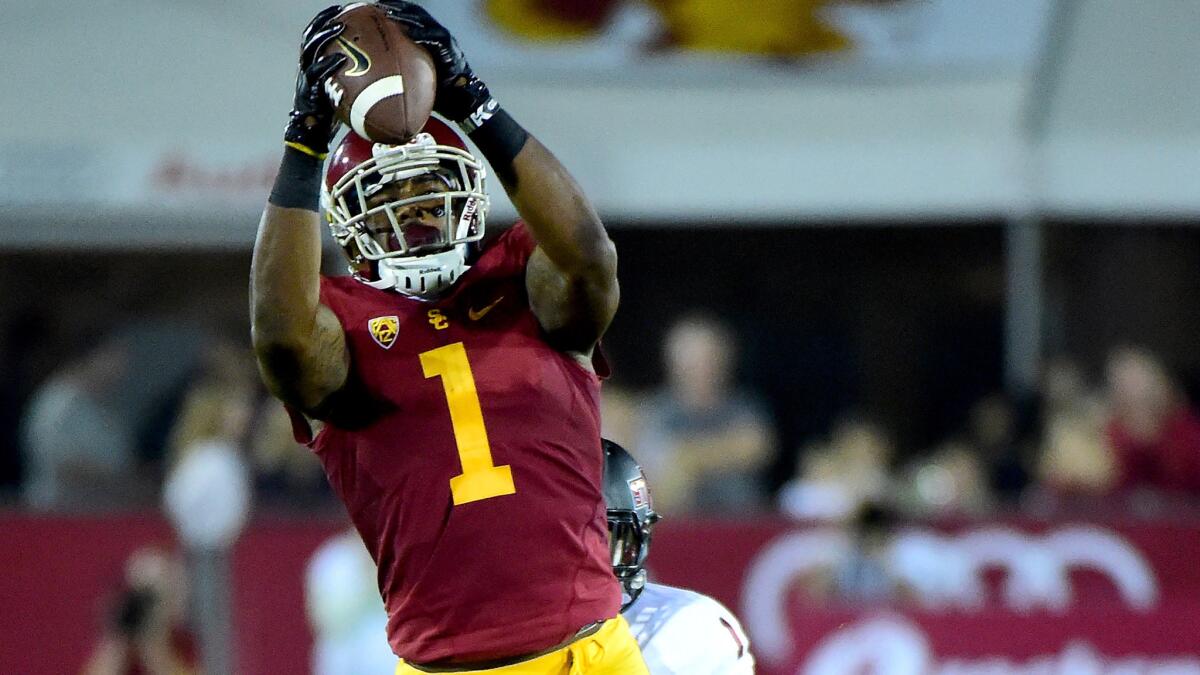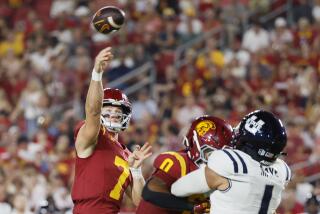USC’s receiving platoon keeps defenses on their heels

USC receiver Darreus Rogers makes a catch against Arkansas State defensive back Blaise Taylor during the season opener on Sept. 5.
- Share via
Darreus Rogers repeatedly burst off the line of scrimmage and ran precise pass routes. The wide receiver aggressively blocked defenders to help teammates. And he did everything with all-out effort on five consecutive third-quarter plays in USC’s victory over Idaho last week.
Rogers then tapped his helmet, a signal to replacement Isaac Whitney that he needed a breather.
On the next play, Rogers watched from the sideline as Whitney broke free for a wide-open touchdown pass from quarterback Cody Kessler.
“I was like, ‘Oh man,’” Rogers said. “But Isaac got his first touchdown. I was proud of my boy. That builds his confidence too, so that’s going to make us a better team deeper into the season.”
USC’s depth at receiver, and willingness to play nearly the entire position group, was evident in early-season routs. Eleven players, including seven receivers, caught passes in a 55-6 victory over Arkansas State. Fourteen players, including nine receivers, had receptions in the 59-9 victory over Idaho.
Coaches said they would continue to go deep into the position group when the sixth-ranked Trojans play Stanford in a Pac-12 Conference opener Saturday at the Coliseum.
“We have a saying,” offensive coordinator Clay Helton said. “We platoon, we don’t sub.”
JuJu Smith-Schuster has a team-best 14 receptions, four for touchdowns. Steven Mitchell Jr. has six catches and Rogers, the third starter, has four.
Backups Whitney, Jalen Greene, Christian Tober and De’Quan Hampton each have at least two receptions, and cornerback Adoree’ Jackson, who also plays receiver, has three.
“We’re not just lining them up,” receivers coach Tee Martin said. “We’re lining them up to give them the ball. They all have special talents and it’s hard to defend when you don’t know who’s getting the ball.”
With USC attempting to push the pace with a no-huddle offense, the receivers are largely responsible for managing the platoon and knowing when to exit and enter games.
Helton compared it to the way Kentucky’s basketball team substituted to keep players fresh.
Coach Steve Sarkisian likened it to another sport. “It’s kind of like hockey,” he said. “You don’t hesitate — you gotta go.”
Helton worked from the coaches’ booth in the press box in 2014, but with Sarkisian ceding play-calling duties to him this season, he is on the sideline during games. Martin moved from the field to the coaches’ booth and he communicates with the receivers at halftime and, when necessary, by phone. Graduate assistant Jaron Fairman also relays information.
“We help them,” Sarkisian said. “We don’t throw them out on an island and they’re on their own.”
During timeouts and other situations, coaches can call for specific receiver groups. “Maybe a big third down or red-zone play,” Martin said.
But otherwise, the players do it themselves.
“It provides tremendous morale,” Helton said, “because each one knows he has a role.”
Those roles, for the most part, are difficult for an outsider to distinguish.
Smith-Schuster’s 10 catches for 192 yards and two touchdowns against Idaho clearly moved him into a No. 1 receiver role.
Or did it?
“We don’t treat it as if there’s a 1, 2, 3 or whatever,” quarterback Kessler said. “Whoever’s in at that spot, whoever’s playing at that time is the guy. I expect you to be where you’re supposed to be and they expect me to have the ball where it needs to be.”
That’s what happened against Idaho, when Whitney came in for Rogers.
Whitney, a transfer from Riverside City College, enrolled at USC in January and initially struggled while learning the offense during spring practice. But he knew the playbook by the time training camp started. So when he replaced Rogers in the third quarter, he ran onto the field, lined up and recognized the coverage.
“I knew it was going to be wide open,” he said, “and I knew I had just to go execute and make a play.”
Kessler hit him in stride for a 28-yard touchdown.
Rogers was happy for his teammate. He is confident his time will come, so he intends to continue blocking with great effort and playing the role of a decoy if necessary.
“I’m a natural competitor,” he said. “I want the ball too, but at the end of the day, you get that victory.”
Twitter: @latimesklein
More to Read
Go beyond the scoreboard
Get the latest on L.A.'s teams in the daily Sports Report newsletter.
You may occasionally receive promotional content from the Los Angeles Times.







